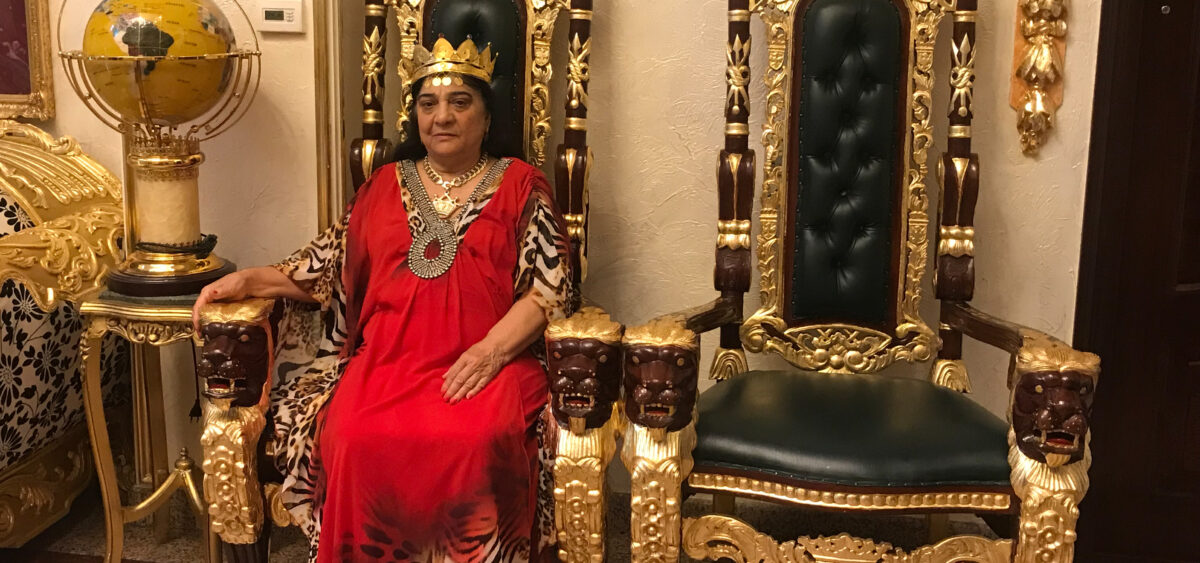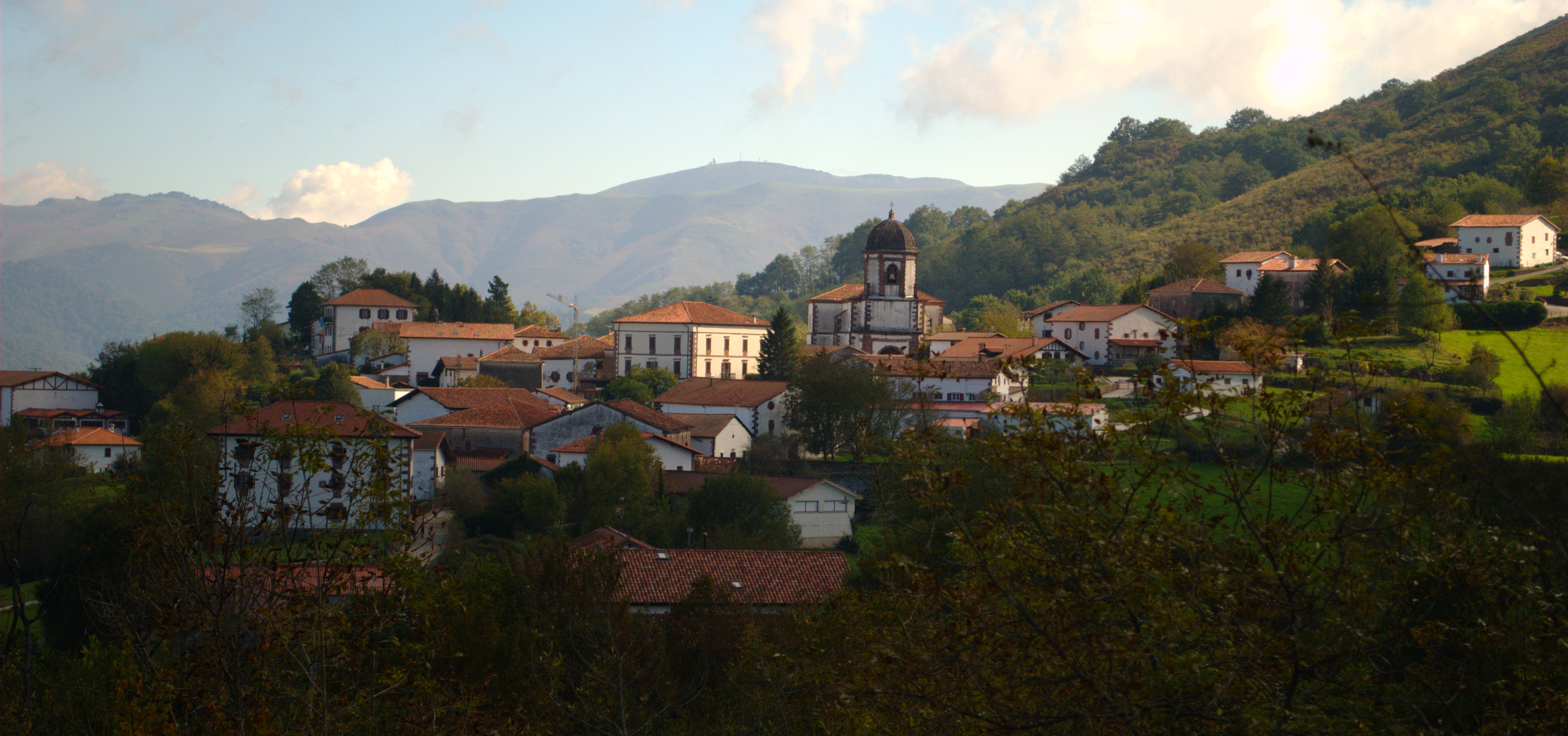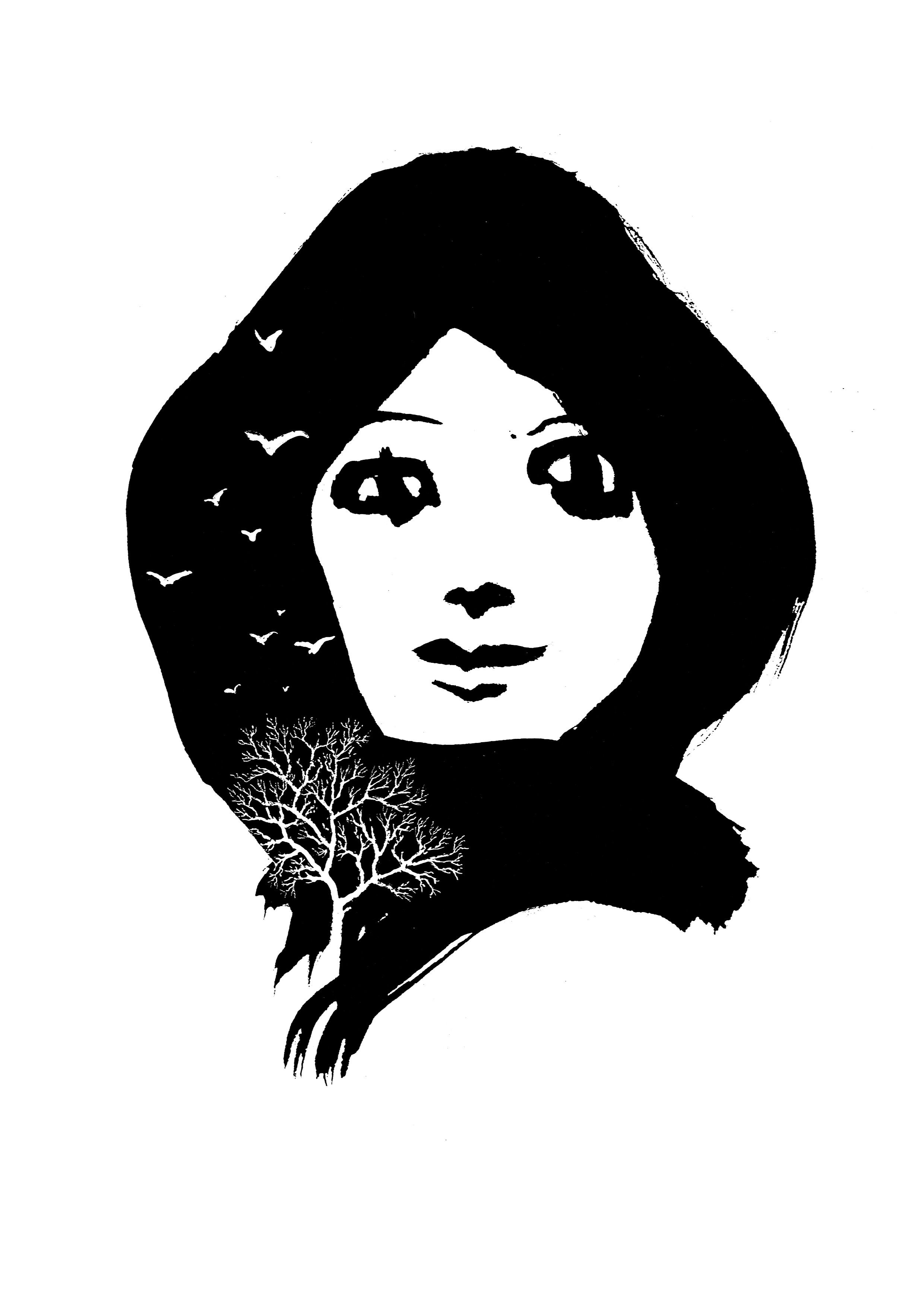
“People think that we’re trapped in the past. Europe is obsessed with integrating us. I created the idea of a cyber-witch and of Roma Futurism to show them that we are people of the future,” declares Mihaela Drăgan, one of the heroes of the third part of the “Witch Hunt” cross-border reportage.
Maria Campina is sitting on a throne in her Bucharest villa, wearing a long red dress and a gold crown weighing half a kilogram. Royalty lines the wall to her left, with a huge picture of herself and Queen Elizabeth II of England, photoshopped by her grandson as a birthday present. Known across Romania as the one and only Queen of Witches, Campina does not talk to anyone who shows up at her door, and her time is precious. She attempts to charge us for the interview, claiming that she had to cancel other appointments for us. Only after we threaten to leave, do we manage to bargain.
Queen Campina speaks without haste, stopping to catch her breath once in a while. She is almost 80 years old, although she refuses to reveal her exact age. “We are witches from mother to daughter,” she claims. “This power is not for everyone. Only my daughters can inherit it.”
The matriarch
Among the monumental pictures of Queen Campina and her family are portraits of her late husband, a former judge in the stabor – an unofficial tribunal of the traditional Roma communities. However, it is Campina who rules this clan.
“My grandmother is the head of this family,” her teenage grandson confirms with a smile, while Queen Campina keeps us waiting. “She is the most powerful witch in Romania.”
Finally, the Queen emerges from her bedroom, situated at the top of a marble staircase, and majestically descends to greet us. Then she rests on one of two golden thrones, the second one belonging to her late husband.
“Tell me what you want. Do you want me to demonstrate how I tell the future?” she urges.

Queen Campina is used to media attention, being a frequent guest on TV shows where she predicts the fortune of local celebrities. One of the richest people in the country, she herself is a celebrity. Her daughter’s lavish wedding and her niece Shakira’s photoshoots attract Romanian paparazzi and tabloid television shows. Yet she has not been interviewed about her job before, and is reluctant to reveal the origin of her special gift.
“I inherited it from my mother and she inherited it from my grandmother, who was a descendent of the Indian maharajas,” she explains.
The title ‘Queen of the Witches’ was given to her by Ion Țugui, a Romanian writer, passionate about the paranormal. He called her “the official Queen of White Magic” in a television show at the beginning of the 1990s, revealing that he had followed her predictions for six years and they had all come true. She, on the other hand, claims she earned the title after successfully performing a ritual and winning a competition with other witches from various countries, which Țugui witnessed.
Campina leads us to the altar room, where her life-size statue is accompanied by a statue of Jesus Christ. On the altar table, there are Orthodox icons and various ‘witch’ dolls that represent the evil fortune tellers who use black magic. Campina first produces an enormous jade presse-papier, which she believes has animalic powers and represents the devil, whom she prays against. Then she demonstrates a large sea shell called ghioc, used by traditional Roma fortune-tellers to see the future.
Queen Campina receives many requests for fortune-telling from abroad, mostly from Romania’s large diaspora. She does not need to see her clients in person in order to carry out the ritual – she uses her phone. In these cases, payment is carried out electronically. Local clients simply put the money in the sea shell, while Queen Campina recites her chants. The real rituals, however, take place at night, on the edge of her garden pond. “Only my daughters and I have access to it,” she reveals.
“There are some who work with black magic, but that’s not me. We’re clean,” she declares and then grows slightly suspicious. “Have you seen someone else? Don’t go to the others. I am the only one who does real magic.”
A country without stakes
Although after 1989 witchcraft became an industry in Romania, it was also a source of privilege under communism. According to Queen Campina, even the feared Elena, the wife of Romania’s communist leader Nicolae Ceaușescu, used to consult fortune tellers, including herself.
“I warned her that there was danger in her future and she just got upset with me.” Queen Campina recalls. “I was afraid that she would have me arrested.” In the 1990s, there were many high profile politicians among her clients, Campina claims, but refuses to specify names.
Witchcraft became a listed profession in Romania in 2011, when the Ministry of Labor decided to include it in the Official Profession Registry and oblige fortune tellers, astrologers, witches and healers to register their businesses and pay taxes. Several bills to regulate their activity failed to pass in the previous year, after groups of self-proclaimed witches, fortune tellers and healers protested at the Parliament, cursing the MPs who had submitted the bills.
“This job is not to be done with receipts,” Queen Campina told the media in 2010.
Between the 16th and 19th centuries, when civil courts across Europe sentenced women to the stake, Romania saw few witch hunts, especially in its Southern and Eastern parts, which were provinces of the Ottoman Empire. The Romanian state and the Orthodox Church were nowhere near as consumed by the witch hunt frenzy as their Western European counterparts. Cluj Napoca-based anthropologist Ioan Pop-Curşeu, the author of Magic and Witchcraft in Romanian Territories, believes that several factors contributed to this state of affairs. One of them was the fact that the Romanian Orthodox Church had a tacit policy of integration and toleration of pre-Christian beliefs, while the population practised a relaxed, informal Christian Orthodoxy.
“That doesn’t mean that the society was not a patriarchal one, or that the Orthodox dogma did not demonize witches, fortune tellers and all ‘devil worshippers’,” Pop-Curşeu points out. Many Romanian Orthodox Churches built during the times of the witch hunts do have representations of hell, portraying women tormented in pitch boilers because they were witches, he adds. However, in reality women deemed witches or accused of witchcraft were never given harsh punishments, only spiritual ones, such as fasting, praying or being temporarily banned from the church, Pop-Curşeu explains.
Another important factor was that, unlike in Western Europe where modern medicine was already developing at universities, in the Romanian-speaking territories, the population was largely dependent on village healers and herbalists, some of whom were, surprisingly, priests.
“In general, witches were crucial for rural communities. They cured illnesses and helped people go through important events in their lives. The fact that witches had a precise and predetermined role that was acknowledged by the entire community, led to a very low rate of witch trials in Romania.”
Power to the witches
“Witches are the only matrilineal tribe of Roma people. All others transmit inheritance through male lineage,” points out Mihaela Drăgan, 34 years old, a Romanian Roma actress and writer. She is the founder of Roma Futurism – an art movement promoting the idea of an empowered Roma woman. “Witches in our community are strong. It’s the only Roma clan that is named after the profession of women,” she argues.
For Roma women in Romania, education or being born into a witch clan are the only alternatives for becoming independent. A study published in 2011 by the Roma Women’s Association shows that most women from the community (some 70%) marry young. They are usually between 16 to 20 years-old, and have children immediately afterwards. Due to early marriage, they also drop out of school. 67% are later unemployed and completely dependent on the family.
According to a report issued by the European Commission in 2018, on the implementation of the Romanian national strategy for the integration of the Roma community, not much has changed for Roma women. The majority of them are taken into consideration only by healthcare programs but not by development or education programs. Moreover, they suffer double discrimination, within their own patriarchal community and the Romanian society at large.
On the other hand, Roma witches, such as Queen Campina, are not only extremely rich but also respected by the community leaders and the outside world. Queen Campina’s grandson’s wedding on October 31, 2019 attracted the wealthiest members of the community and was also aired on several television stations as the “wedding of the year”. The most notorious Roma musicians in the country, such as Adi Minune and Sorinel Pustiu, performed.
For Drăgan, the success of the Roma witches went beyond ‘exotic’ traditions and folklore. She saw it as an opportunity to rebrand the image of Roma women, by showing who they can become if they are left to reach their potential. She took the label ‘witch’, given to the women by the society because of their ‘exotic’ look, and decided to turn it into a matter of pride.
“I imagine the witches of the future, the cyber-witches,” she smiles while braiding her hair before one of her plays, Kali Traš.
Kali Traš, which means ‘Black Fear’ in Romani, is – alongside Porajmos (‘swallowing’) or Samudaripen (‘mass killing’) – the name of the Roma genocide, initiated by the Nazis during World War II. According to various estimates, 25% to 50% of Roma people living in Europe at that time were murdered. Drăgan’s play is the story of two women and two men – a musician, a sword-swallower, a fortune-teller and a puppeteer – who are deported to Transnistria by the fascists. It has been one of the most popular plays in the National Jewish Theatre in Bucharest for the past two years. It is largely presented through the eyes of two women characters, who share a fortune-telling scene on stage, during which they chant and throw fava beans on the ground. They are telling the fortune of Ioan Antonescu (Romania’s fascist prime minister during World War II) and the fate of her own people deported to Transnistria by the Nazi-allied government.
“Girl, don’t you know it’s all an act? It’s for the gadjii [‘outsiders’ in the Romani language], not for us,” Drăgan’s partner on stage, Zita Moldovan, tells her character.
For Drăgan, performance is everything. Onstage, she tells the stories of Roma women and battles stereotypes surrounding them. The actress grew up with two sisters in her grandparents’ home in Buzau, a town 108 kilometers north of Bucharest, while Drăgan’s parents moved to Constanta to work in a refinery. Her grandfather was a lautar (‘fiddler’ in Romanian) and played at weddings and funerals. This is where her dream of becoming an actress was born.
Cyber-witches
On May 25, 2019, at 6.30am, Drăgan was dressed up for some magic. The actress met with a coven of some of the most notorious Roma witches in the country to conduct a ritual in front of Romania’s colossal Parliament Palace “for the European elections to run smoothly”. The head of the coven, Mihaela Minca, and her daughter, Casanndra Buzea, gave their blessings to the elections after laboring the whole night performing rituals for the country. “May we have antiracist politicians to represent us in the European Parliament!” Drăgan wrote on her Facebook account, posting a picture of Minca and Buzea.
According to tradition, the gift should remain in the family, which is why Minca’s famous coven is made of her own daughters. Two weeks before the elections, she announced on Facebook that she would perform an “anti-corruption ritual for the prosperity of the country” before the European elections. She had already started on March 30, by broadcasting prayers against the government.
“I, along with the most powerful witches, have decided to change the political world for the better. Just watch it. We are working against corruption in our country,” she claimed.
The leader and her daughters use social media to reach out to clients, promote their work and keep in touch with peers abroad. Minca and Buzea are very active on Facebook, while the second daughter, Anda, takes care of the coven’s Instagram account.
For Drăgan, their story is not just that of a successful business. It is a fight against racism and the long history of persecution and ‘integration’. The fact that Roma women are usually associated with witchcraft has become a stigma, but Drăgan wants to spin it:
“Inspired by Afro-futurism and Sino-futurism, I wanted a project on Roma futurism,” she explains with a smile. “People think we’re trapped in the past. Europe is obsessed with integrating us. I created the idea of a Roma cyber-witch and of techno-witchcraft to show them that we are also people of the future.”
This story is part of the cross-border reportage project “Witch Hunt”. The research was enabled by a Reporters in the Field grant from the Robert Bosch Foundation. You can access the first and second episodes here.










